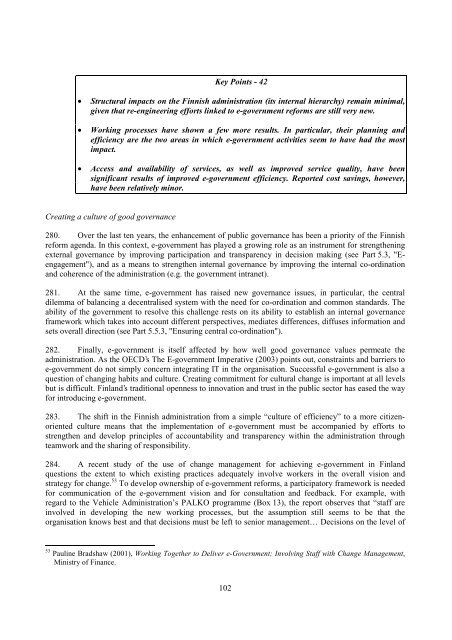e-GOVERNMENT IN FINLAND - ePractice.eu
e-GOVERNMENT IN FINLAND - ePractice.eu
e-GOVERNMENT IN FINLAND - ePractice.eu
Create successful ePaper yourself
Turn your PDF publications into a flip-book with our unique Google optimized e-Paper software.
Key Points - 42<br />
x Structural impacts on the Finnish administration (its internal hierarchy) remain minimal,<br />
given that re-engineering efforts linked to e-government reforms are still very new.<br />
x Working processes have shown a few more results. In particular, their planning and<br />
efficiency are the two areas in which e-government activities seem to have had the most<br />
impact.<br />
x Access and availability of services, as well as improved service quality, have been<br />
significant results of improved e-government efficiency. Reported cost savings, however,<br />
have been relatively minor.<br />
Creating a culture of good governance<br />
280. Over the last ten years, the enhancement of public governance has been a priority of the Finnish<br />
reform agenda. In this context, e-government has played a growing role as an instrument for strengthening<br />
external governance by improving participation and transparency in decision making (see Part 5.3, "Eengagement"),<br />
and as a means to strengthen internal governance by improving the internal co-ordination<br />
and coherence of the administration (e.g. the government intranet).<br />
281. At the same time, e-government has raised new governance issues, in particular, the central<br />
dilemma of balancing a decentralised system with the need for co-ordination and common standards. The<br />
ability of the government to resolve this challenge rests on its ability to establish an internal governance<br />
framework which takes into account different perspectives, mediates differences, diffuses information and<br />
sets overall direction (see Part 5.5.3, "Ensuring central co-ordination").<br />
282. Finally, e-government is itself affected by how well good governance values permeate the<br />
administration. As the OECD’s The E-government Imperative (2003) points out, constraints and barriers to<br />
e-government do not simply concern integrating IT in the organisation. Successful e-government is also a<br />
question of changing habits and culture. Creating commitment for cultural change is important at all levels<br />
but is difficult. Finland’s traditional openness to innovation and trust in the public sector has eased the way<br />
for introducing e-government.<br />
283. The shift in the Finnish administration from a simple “culture of efficiency” to a more citizenoriented<br />
culture means that the implementation of e-government must be accompanied by efforts to<br />
strengthen and develop principles of accountability and transparency within the administration through<br />
teamwork and the sharing of responsibility.<br />
284. A recent study of the use of change management for achieving e-government in Finland<br />
questions the extent to which existing practices adequately involve workers in the overall vision and<br />
strategy for change. 53 To develop ownership of e-government reforms, a participatory framework is needed<br />
for communication of the e-government vision and for consultation and feedback. For example, with<br />
regard to the Vehicle Administration’s PALKO programme (Box 13), the report observes that “staff are<br />
involved in developing the new working processes, but the assumption still seems to be that the<br />
organisation knows best and that decisions must be left to senior management… Decisions on the level of<br />
53<br />
Pauline Bradshaw (2001), Working Together to Deliver e-Government; Involving Staff with Change Management,<br />
Ministry of Finance.<br />
102
















